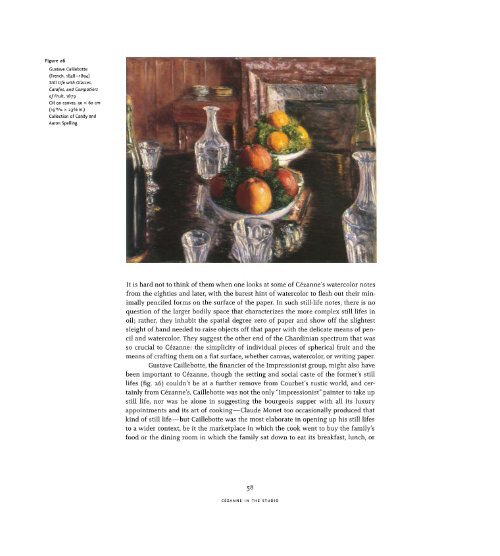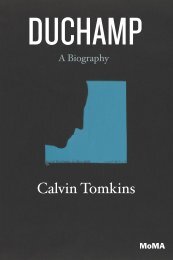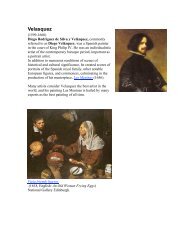Still Life in Watercolors
qbj8dgc
qbj8dgc
- No tags were found...
You also want an ePaper? Increase the reach of your titles
YUMPU automatically turns print PDFs into web optimized ePapers that Google loves.
Figure 26<br />
Gustave Caillebotte<br />
(French, 1848-1894)<br />
<strong>Still</strong> <strong>Life</strong> with Glasses,<br />
Carafes, and Compotiers<br />
of Fruit, 1879<br />
Oil on canvas, 50 x 60 cm<br />
(i9 11 /i6 x 23 5 / 8 <strong>in</strong>.)<br />
Collection of Candy and<br />
Aaron Spell<strong>in</strong>g<br />
It is hard not to th<strong>in</strong>k of them when one looks at some of Cezanne's watercolor notes<br />
from the eighties and later, with the barest h<strong>in</strong>t of watercolor to flesh out their m<strong>in</strong>imally<br />
penciled forms on the surface of the paper. In such still-life notes, there is no<br />
question of the larger bodily space that characterizes the more complex still lifes <strong>in</strong><br />
oil; rather, they <strong>in</strong>habit the spatial degree zero of paper and show off the slightest<br />
sleight of hand needed to raise objects off that paper with the delicate means of pencil<br />
and watercolor. They suggest the other end of the Chard<strong>in</strong>ian spectrum that was<br />
so crucial to Cézanne: the simplicity of <strong>in</strong>dividual pieces of spherical fruit and the<br />
means of craft<strong>in</strong>g them on a flat surface, whether canvas, watercolor, or writ<strong>in</strong>g paper.<br />
Gustave Caillebotte, the f<strong>in</strong>ancier of the Impressionist group, might also have<br />
been important to Cézanne, though the sett<strong>in</strong>g and social caste of the former's still<br />
lifes (fig. 26) couldn't be at a further remove from Courbet's rustic world, and certa<strong>in</strong>ly<br />
from Cezanne's. Caillebotte was not the only "Impressionist" pa<strong>in</strong>ter to take up<br />
still life, nor was he alone <strong>in</strong> suggest<strong>in</strong>g the bourgeois supper with all its luxury<br />
appo<strong>in</strong>tments and its art of cook<strong>in</strong>g—Claude Monet too occasionally produced that<br />
k<strong>in</strong>d of still life—but Caillebotte was the most elaborate <strong>in</strong> open<strong>in</strong>g up his still lifes<br />
to a wider context, be it the marketplace <strong>in</strong> which the cook went to buy the family's<br />
food or the d<strong>in</strong><strong>in</strong>g room <strong>in</strong> which the family sat down to eat its breakfast, lunch, or<br />
58<br />
CÉZANNE IN THE STUDIO




